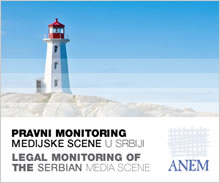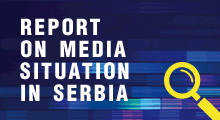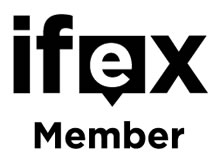Home
/
Media Scene
/
Region and world
08. 06. 2005
FEEDING ON INCIDENTS
When the well-known Belgrade tennis player Boba Zivojinovic and his wife, the popular star singer Lepa Brena, laid flowers at a memorial for victims of war in Tuzla in August 2004, Belgrade’s highest circulation tabloid Kurir commented on their gesture in a severely criticizing and belittling article under the headline “Zivojinovics discredited Serbs.” The reason to crucify the known couple in the media was the fact that they had taken flowers to the memorial which carries the following inscription: “In this place, on May 25, 1995, the Serbian fascist terror ended 72 young lives by shelling. “ The truth about Serbian crimes in the wars in the former Yugoslavia is still a subject seldom and unwillingly written about and gestures that point to these crimes are mostly taken as hostile ones. Nevertheless, the above example would most probably be impossible if the language of public communication was not at a very low level generally speaking, full of discrimination of political opponents, different opinions and all things that are different, based on intolerance and stereotypes established in the press during the pre-war and wartime years. Before the democratic changes in 2000, the media in Serbia were classified into pro-regime and so-called independent media, the former having a clear characteristic of warmongering reporting, production of lies against the nations Serbia was at war with (although no war was ever officially declared) and hate speech about all those who were different or thought and spoke differently. The so-called independent media, very close to opposition parties, which were privately owned and appeared in 1996, followed a line of anti-war journalism and advocated tolerance and dialogue. After the democratic changes, this classification disappeared, and the hopes of all those who had expected the independent media to take over the dictate of media conduct and the enlightening role of promotion of dialogue and tolerance, as opposed to hate speech, were disappointed. After 2000, what has been happening in Serbia is commercialization of all media and transformation of the press into tabloids. Commercialization of independent media has resulted in their adjustment to the prevalent public opinion, which is conservative and reactionary for it had been filled with the propaganda of the regime media for more than ten years. Commercialization and appearance of tabloids, in reaction to the mastering of freedom after the fall of the communist regime as in other countries of South East Europe, has led all Belgrade press, with some small examples that confirm the rule, to continue to foster the same pattern of hate speech and stereotypes that had actually led to the wars in the territory of the former Yugoslavia in the nineties of the previous century. These patterns are more concealed and nicely packed, the frequency of their appearance is lower, and they are less drastic. Even so, at times of crises and conflicts, they appear with the same intensity, thus showing their vitality in public communication. Preparing the ground for war Many studies and researches on the role of the media in the conflicts in the former Yugoslavia, and Serbia under Milosevic was no exception, quite the contrary, have shown unequivocally that the media, by serving the regime in power, had generated the wars and hate and then supported them. In his book “Production of War,” Mark Thompson decidedly concludes that verbal violence produced physical violence and that the war first started in the media. The Italian journalist Paolo Ramires in his book “A Massacre” also wrote this: „War had been present in the headings and articles in the Belgrade daily Politika as far back as 1988.” Armed war started three years later – in 1991. What is usually used as the argument to allege that media warfare preceded the “real” war are the words of former Serbian President Slobodan Milosevic, at a celebration of the 600th anniversary of the Kosovo battle, when he warned the several hundred thousand people present that “six centuries later we are again in battles and disputes. These are not armed battles, but such battles cannot be excluded.” These words were the credo of the editors of the Serbian media controlled by Milosevic. Naturally, these media had previously gone through a process of “purification” and editors and journalists who thought differently had been expelled from them. On the eve of the war in Croatia, the Politika daily, reporting on the events in the Krajina – a part of Croatia with a Serbian majority – applied the same, well-worked out pattern of a conflict with a single victim. On the occasion of a decision passed by the Serbian National Council from Knin on September 30, 1990, to declare total autonomy for Serbs in Croatia, the following headings appeared on the pages of Politika the next day and during October: “Serbian Children as Hostages,” “Attacks on Serbian People, Resistance to Terror of Ustasha Authorities by All Means,” “Ustasha Destroy Yugoslavia and Pass Responsibility to Serbs,” “Special Police Speak Shiptar”... One-sidedness in new conditions The stereotypical reporting about the ethnic conflicts wherein the Serbs were the only victims did not change in 2004, either. During the violence in Kosovo on March 17, the Serbian media reported only about Serbian victims. On March 19 the Politika published on its cover page an article under the title “Serbs in State of Anxiety and Fear,” where it is said that 31 persons were killed and 500 injured, not mentioning the nationalities of the victims, but the journalist unequivocally alluded that they were solely Serbian victims: “One is right to fear that the number of victims will be higher, for the international forces did not reach all villages that were targets of Albanian extremists.” Suppression of the fact that there were also Albanian victims killed and injured in conflicts with the international military and police forces in Kosovo did not inflate the picture of the Serbian suffering that was terrible, but it did lower the reputation of the Serbian media and show a large dose of their incapability or even unwillingness to report objectively about such a horrible and painful issue, as the majority of Serbs view the suffering of their fellow-countrymen in Kosovo. At the same time, it also served to play up on the hate towards all Albanians. Reporting on the events in Kosovo on March 17, 2004, when many Serbian homes and Orthodox churches from the Middle Ages were burnt down and many Serbs had to be evacuated, the press did not succeed, or did not want, because of Serbian readers’ expectations, to establish a professional distance. On March 18, all cover pages of the Belgrade dailies featured the following: “War in Kosovo,” “Terror against Serbs,” “Albanians Invaded Serbian Villages,” “Organized Attacks by Albanians against Serbs all over Kosovo Killed 10 and Wounded Almost 300 People,” “Nine People Dead,” “Serbian Homes and Churches on Fire.” The fact that hooligans in Nis and Belgrade demolished and burnt down mosques was absolutely minimized and even justified in some cases. The most militant representatives, who wanted bloody revenge and the Serbian army to go to Kosovo, were most frequently given a chance to speak. It was obvious that all media made effort to contribute to the flames of hate, hunger for revenge and new demonstrations being stirred. Referring to the torching of the Bajrakli mosque in Belgrade, the Nacional daily brought this headline: “The most violent reaction of citizens who gathered spontaneously because of the latest organized killing of the Serbs in Kosovo occurred in Belgrade two nights ago”, and the heading: “The Young Will Not Give Kosovo Away!”, also quoting one of the hooligans who took part in the mosque torching: “This is not to pay you back for the Serbian victims and the torching of all the Serbian sacred places. This is a low price you are paying.” Belgrade’s highest circulation tabloid Kurir immediately gave its pages to a defendant in The Hague for crimes in Kosovo, General Vladimir Lazarevic, who said: “Arms against arms. The international community has been in this region for five years and nothing has been achieved and Serbia must now present an ultimatum to the peacekeeping forces. If they do not stop the violence by a certain date, our army should be engaged to protect the Serbian people.” In the days following March 17, the media heavily used the abusive expression Shiptars for Albanians, which had been rooted out from public communication with great difficulty and to a large extent after the democratic changes in 2000. The boiling passions were difficult to calm down and the violence by the Albanians and alleged plans for new violence against Serbs were the topics of newspapers almost until the end of 2004. Let us mention that even the most moderate daily Politika, formerly one of the two main pillars that supported Milosevic’s coming and staying in power, on June 11 published a commentary entitled “A Lecture on Defeat,” claiming that “Albanians do not believe in anything in such a fascinating manner as in the effectiveness of violence. There is no prize or punishment for them in a political and civilized sense. As the poor victims, they have made powerful friends, understanding their role as a perfect shelter for crimes.” Model of antagonism To generate war and conflict, to get even with enemies more easily, the enemies being other nations and political opponents, the media had to develop and introduce simple models and easily recognizable stereotypes into public language. The model of antagonism was one of the dominant models. As described by the sociologist Srecko Mihajlovic in his book “War Started at Maksimir Park,” in the model of antagonism there are always the guilty and the innocent, the culprits and the damaged party, absolute good and absolute evil. For example: “We are the best, the cleverest, the strongest, the most beautiful, we are the nation with the longest tradition, we are so very much the most that even our defeats are outstanding, our defeats are more glorious than our victories, we celebrate our defeats, we are on the side of justice, God, world, Europe. On the other hand, they are the worst, they are absolute evil, there is no peace with them, they should be exterminated, all our past, present and future is their fault, they are our great excuse....” In the case of Serbia, “they” changed depending on need: Slovenes, Croats, Moslems, and in most cases, due to the conflict that lasted in Kosovo for a long time, “they” were Albanians. The model of antagonism prevailed in the Serbian media for more than ten years. With the process of democratic changes in 2000, the official policy promoted advocacy of multi-culture in the sphere of public opinion, but it has not yet succeeded in truly pushing back the previous pattern, which has deep roots and is applied even today. One of the important obstacles to abolishing the model of antagonism and the negative stereotypes is the fact that lustration has not been carried out in the press in Serbia and that practically the same journalists and editors who excelled in hate speech have continued to work in the same positions. Such an example is the case of the daily Vecernje Novosti, which spearheaded the nationalistic campaign to implement the project of a Greater Serbia in the nineties as the newspaper with the largest circulation in Serbia, and which at present recognizably toes the line of rightwing populism. During the war in Bosnia, the Vecernje Novosti often used to mislead its readers through a grotesque campaign, not hesitating to use lies to encourage hate and warlike sentiment of its readers. A known example is November 19, 1994, when an article under the title “A Painful Memory,” which says that children are the greatest victims of the war in which the Serbs are fighting for mere survival, was illustrated with a photograph of a boy lying on a snow covered grave. The illustration allegedly showed a Serbian orphan from Bosnia who was mourning his family killed in a Moslem offense. The photograph was actually a painting under the title “At the Mother’s Grave” from 1879 held at the National Museum in Belgrade. Even after the democratic changes and arrival of a new editorial team, the Vecernje Novosti continued a similar practice of emotional harassment of its readers through photographs that incite hate, in relation to Moslems and Albanians in particular. It is highly commendable that the photographs are no longer false, but the practice of publishing photographs of Serbian heads severed in Kosovo or Bosnia on cover pages is in fact based on warmongering hate speech produced during the wars in the former Yugoslavia. As a drastic example we can mention the issue of November 3, 2003, wherein the Vecernje Novosti published on the cover page a photograph of a member of the Kosovo Liberation Army (KLA) holding a severed human head in his hand, allegedly belonging to a Serbian soldier, and putting it into his bag. Soon afterwards, on November 7, 2003, while readers’ emotions were still shaken, the Vecernje Novosti published a similar story about Moslems in Bosnia who allegedly also severed Serbian heads. Under the title “27 Serbian Heads as a Gift to Alija,” the newspaper wrote that “captured Serbian fighters in Bosnia were forced by mujahedins to kill each other with knives, they were hammered to a fence live and nails were driven into their intimate parts. In the end, their heads were severed.” Without getting into the truthfulness of the two above mentioned stories about crimes committed by Albanians in Kosovo and Moslems in Bosnia and their foundation in investigative journalism, the fact remains that the Vecernje Novosti, like the vast majority of other Serbian newspapers, so far has not properly tried to shed light on crimes committed by Serbs. Such an editorial policy of the majority of the Serbian media only acknowledges the old model of antagonism and incites hatred against ethnic minorities. The period of warmongering journalism in the media controlled by the regime of Slobodan Milosevic, as established by Stjepan Gredelj (study “The Happening of the Nation in the Media – Media Generation of Conflict”) in an analysis of the Politika and Borba dailies from 1987 to 1990, was characterized by neglecting facts to a large extent and not mentioning sources of allegations. Gredelj writes: “In almost one-half of the articles in the Politika the source is not mentioned, plus every seventh author is his own source, while in the Borba, in addition to almost one-third of the articles not having the source mentioned, as many as one-fifth of the articles are primarily based on the author’s direct view.” Gredelj concludes that this is “impressionistic journalism,” ”journalism with a thesis,” rather than informational and analytical journalism. This manner has been maintained to this day, especially in the type of articles as the two above mentioned articles. Yielding to the taste of public opinion An important difference between hate speech in the media before and after the democratic changes lies in the fact that after 2000 there is no controlled conduct from one power center any longer. While the Serbian media incited hatred against other nationalities during and under the control of Milosevic’s regime because they were requested to do so, the “freed” media continued to do so in order to please the taste of the public at large. A research and analysis of the Belgrade press carried out by the Helsinki Human Rights Watch in Serbia during 2004, under the indicative title “The Press: Unchanged Pattern,” explicitly describes the unfavorable position and treatment of national minorities in the Serbian media: “The context in which minorities appear in the media is extremely politicized and reduced to clashes and conflict situations. Public opinion sooner reacts to the putting up of a plaque in memory of the Ustasha in neighboring Croatia than to violence against minorities in Vojvodina.” An undifferentiated approach plays up on the prejudice that not only are minorities homogenous, “unlike us,” but “they are all the same.” Effort to expose diversity in a different and socially acceptable way ends in most cases in pre-modern perception of minorities as exotic, folklore groups; this perception serves to assimilate rather than affirm cultural identity. All the antagonisms from the period of Milosevic's regime are still constantly present, although in much milder and more perfidious forms. This means that old stereotypes and hate speech are present against Albanians, Moslems from Bosnia and Sandzak (the southwestern part of Serbia with a Moslem majority), against Hungarians from the northern Serbian province of Vojvodina from time to time, but against the international community as well, which cannot be forgotten the bombing of Serbia in 1999 and “forgiven” for insisting on extradition of suspects for crimes and genocide to the Hague Tribunal, starting with General Ratko Mladic. As regards xenophobia and hate speech cherished in the media in relation to the international community, a doubly schizophrenic attitude can be observed. Statements by senior domestic statesmen and politicians about the “acceptance of the European road and European standards” and about Serbia’s desire to become a part of EU as soon as possible are very positively stressed, and the need for all kinds of harmonization with European legislation, models of conduct, and respect for human and civil rights is promoted. At the same time, often obscure texts are published which belong to the type of “impressionistic journalism” where there is a mixture of rigging facts and manipulating readers' feelings, in order to incite hate and hostility towards the “rest of the world” that had bombed Serbia. One such example is an article in the Vecernje Novosti under the title “The Horror Marked 238,” published on February 20, 2005. The superscript title is “Leaders of Italy in Panic How to Hide or Explain the Epidemic of Death of Its Soldiers, Now Civilians, Who Served in Bosnia-Herzegovina and Kosovo.” Accompanied by four large color photographs showing the faces of unknown children with terrible deformities who are insinuated to be children of civilians who suffered radiation exposure in Bosnia and Kosovo, the article, which is a mixture of imagination and facts without mentioning the source, alleges that the children of all those who were near bombing sites in Bosnia and Kosovo, and probably in the entire Serbia, too, are in danger because of depleted uranium 238. The article fits perfectly into the developed stereotype of an unjust international community that neither means well nor does well to the Serbs. Laws and codes In Serbia, since the democratic changes in 2000, all formal and legal assumptions have been established for sanctioning and preventing hate speech in the media. However, not a single case of court sanctions for hate speech in the media has been reported in spite of occasional explicit excesses. It is interesting that neither media analysts nor government institutions have dealt seriously with this matter, and therefore there has been no research into hate speech in the media since 2000, except for a study done by the Helsinki Human Rights Watch in Serbia relating to 2004 only. The Law on Public Information, adopted in 2003, says in Article 38: “It is prohibited to publish ideas, information and opinions that incite discrimination, hate or violence against persons or a group of persons because they belong or do not belong to a certain race, religion, nation, ethnic group, sex or because of their sexual orientation, regardless of whether a criminal act was committed by such publishing.” The same law, in Article 39, stipulates that any physical person referred to by the information from Article 38 may sue the journalist or the editor of the newspaper wherein the information was published, and also that charges can be filed by any legal person whose aim is to protect the freedoms and rights of human beings and citizens, as well as an organization whose aim is to protect the interests of the groups in Article 38. The law envisions a prison sentence of up to three years for violation of Article 38. However, implementation of Articles 38 and 39 is aggravated by Article 40 related to exemption from responsibility. Article 40 states: “There will be no violation of the prohibition of hate speech if the information contained in Article 38 is part of a scientific or journalistic article, and is published without intent to incite discrimination, hate or violence against the persons or group of persons from Article 38, especially if it is part of objective journalistic reporting.” Also, there is no violation of the prohibition of hate speech if one writes with the intention to “critically point out discrimination, hate and violence against the persons or group of persons from Article 38, or phenomena that represent or may represent encouragement of such conduct.” Associations of journalists in Serbia have included in their codes of ethics the prohibition of all kinds of discrimination and abuse of stereotypes. The Independent Association of Journalists, for example, adopted its Code of Ethics in 2003 and it states that “journalists must not create, use, encourage or justify stereotypes when writing about issues related to any social groups (nations, minorities, groups established on the basis of political, religious, interest, racial, historical, sexual or any other commitment or belief). Any form of discrimination of any social group is considered a severe form of violation of this Code. Manipulation with belonging to a certain social group is considered a severe form of violation of this Code. Journalists are obliged to stick to this principle in all circumstances. The problem is that the associations of journalists have not dealt with violation of this part of the code in practice. In his book “Ethics in the Media,” Luis Alvin Day says that civil society does not depend on social or state control of expression. Stressing that this matter must be approached from an ethical side, Professor Day writes: “Even those who despise civility have the right to ask for a hospitable stand to propagate their messages from. However, media employees, except in cases where the law stipulates freedom of approach, do not have a moral obligation to adjust to the providers of hate speech.” In the Serbian press, in contrast to this, there prevails an exaggerated tolerance towards those who spread hate speech, which in most cases is justified by the commercial effects that they have in the Serbian press, usually allowing them wholeheartedly to spread their ideas. Fabricating problems The treatment of minorities in the northern Serbian province of Vojvodina, Hungarians in particular, in the Serbian press is also subject to stereotypes. On the one hand, the press mainly conceals violations of human and minority rights in Vojvodina, and on the other, all incidents caused by members of the Hungarian national minority are very frequently dramatized and labeled as separatism. In the course of June 2004 a specific kind of media campaign started on the occasion of a simple fight in a pub in Vojvodina that was claimed to be a nationalistic attack on Serbians by Hungarians. A Serb was the victim in the pub fight and Hungarians were the attackers. High-circulation media needlessly insisted on the nationalities of the people involved in the fight, although the very victim immediately denied any national context behind the fight. This event was accompanied by the sub-headings “The resurrection of Hungary” and comments that “the event, by its monstrosity, reminds of an event in the eighties in Kosovo when Djordje Martinovic was badly wounded.” The high-circulation tabloid Kurir, writing about the incident under the large heading “The Stake,” abstracted in the subheading an interpretation of the incident provided by an unidentified vendor from Temerin market: “Had a Hungarian been brutally beaten, instead of a Serb, you would have seen how long it would take all Hungarians to gather.” The same unidentified commentator says in the article that “although there had been no conflicts on national ground before, I am sure this is the very reason why the poor young man was massacred in this way. The Hungarians who beat him like an animal and gave vent to their lower instincts would never do anything like that to one of their own. Regardless of how drunk or doped they were, or with thick (police) records, as these ones have, they would not attack their own.” The Kurir described the atmosphere in Temerin town after the event only through the statements of two Serbian young men. One of them commented: “I do not know what happened to this young man to go to the Hungarian pub, but it all started there... I do not hate other nations, including Hungarians, but I have never liked associating with them. We know that everyone should be with their own and should not mix with others.” In addition to national belittling, there is also sexual belittling Attitude to women, especially members of national minorities, is discriminatory, patriarchal and conservative in the Belgrade media. Persistent refusal of newspapers to introduce feminine forms of terms for professions may be mentioned as the smallest detail indicating unequal treatment of the sexes in the media. In most cases, they solely use masculine forms – doctor and not lady doctor, minister and not lady minister, although there are women who exercise these functions or have a certain title. Marina Blagojevic, a female sociologist, observed in a study on misogyny from 2002 (published in “Ethnic Stereotypes,” Nova Srpska Politicka Misao, Belgrade) that in Serbia in the nineties “the men’s fear of losing the privileges given to them by the agrarian and industrial patriarchies has burst into flames.” She noticed that the following negative stereotypes about women were cherished in the media: “nagging wife,” “spiteful mother-in-law,” “mean stepmother,” “unfaithful girlfriend,” “fatal woman,” but also the following positive stereotypes that are in harmony with the patriarchal manner of thinking: “wife who sacrifices herself till she dies,” “faithful wife who waits long for her husband,” “mother who accepts her son unconditionally and gives him refuge.” In the Politika daily, readers can regularly read Sunday columns written by a certain Professor Jova Tosevski wherein he writes about women in a discriminatory way as lower human beings, who are explicitly made for human reproduction. This is, however, a drastic example of misogyny in the Serbian press. It is not as open as in these columns although it is omnipresent. A belittling attitude towards women is reflected in articles on trafficking in women in a particularly bad manner. In a booklet published by the women’s non-governmental organization ASTRA in 2001, more than 100 newspaper articles about trafficking in women from the Politika, Blic, Danas, Glas Javnosti and Vecernje Novosti were analyzed. The results showed that all these newspapers wrote about trafficking in women in the same way, i.e. the actors and the victims were named similarly. In newspapers, trafficking in women, children and men is called “prostitution, black market, Balkan business with human bodies, white slavery,” and is seldom called by its proper name: trafficking in humans, which clearly points out the essence of the problem. When the victims of traffickers in humans are called “prostitutes,” journalists usually give them the following adjectives: “scared, young, expelled, imported, prostitutes at auction, sellers of sexual services, beauties of the night, entertainment ladies, cheap sellers of love, ladies of suspicious moral, consorts...” The term “slaves” has the following sub-variants: “white slavery, white slaves, sex slaves, modern slaves.” There are also the expressions: “attractive girls, ladies, hostesses, naive, picked off the asphalt, inventory of the local pubs, goods from the East for truck drivers, cheap labor.” There are a lot less imaginative names for traffickers: “pimps, procurers, bosses, owners, and black marketers.” A special group consists of expressions that brand the Albanian national community as a group supposed to be very active in this business: “Albanian mafia, Albanian owners, Shiptar mafia, Albanian managers, Albanian criminals, Albanian goons, former members of KLA...” Linguists and sociologists keep warning that such names blur trafficking in women because they do not tell anything about the role of the persons who carry out trafficking in women. Relating this crime to a national minority (it is suppressed that the Serbian majority is also involved in it) creates an additional problem. The above mentioned expressions, in addition to not being clear, reinforce the existing negative stereotypes of women as victims of trafficking in humans, who must be immoral, naive or stupid if something like that happens to them. The Serbian press is characterized by a very low level of communication among those who do not share the same opinions, primarily political opponents who make effort to be as ruthless and offensive as possible in mutual communication and judgments. The atmosphere they create, with media assistance, prevents to a large extent the introduction of political correctness in relation to national minorities, women, sexual minorities, refugees and similar groups that are discriminated in the media. One must bear in mind that the aim of this analysis is to emphasize the most drastic examples of hate speech in the media in Serbia. Although some parallels have been drawn between the period of Milosevic’s rule and the period after the democratic changes in 2000, similarities in the conduct of the press primarily lie in the use of patterns and stereotypes. The very forms of its appearance, of course, are less common and milder than in the time before 2000. Tamara Spaic is a journalist of the Blic daily.
-
No comments on this topic.





